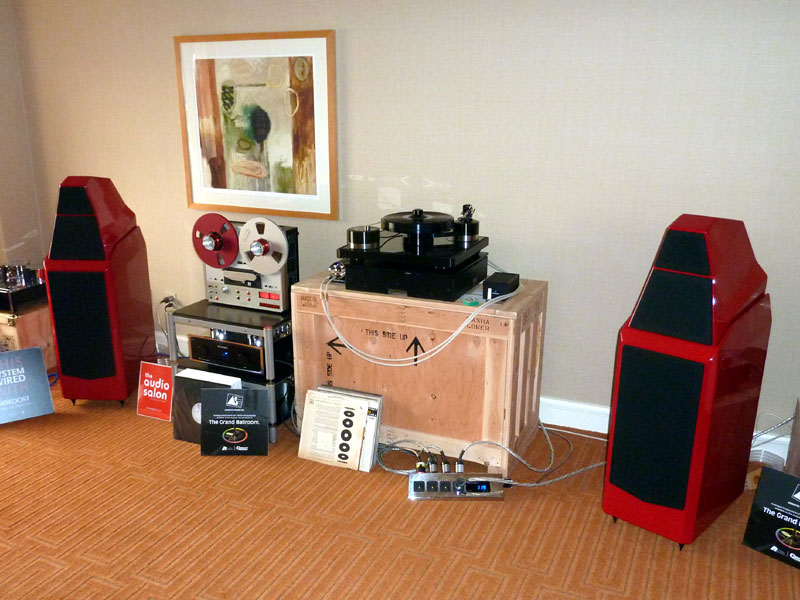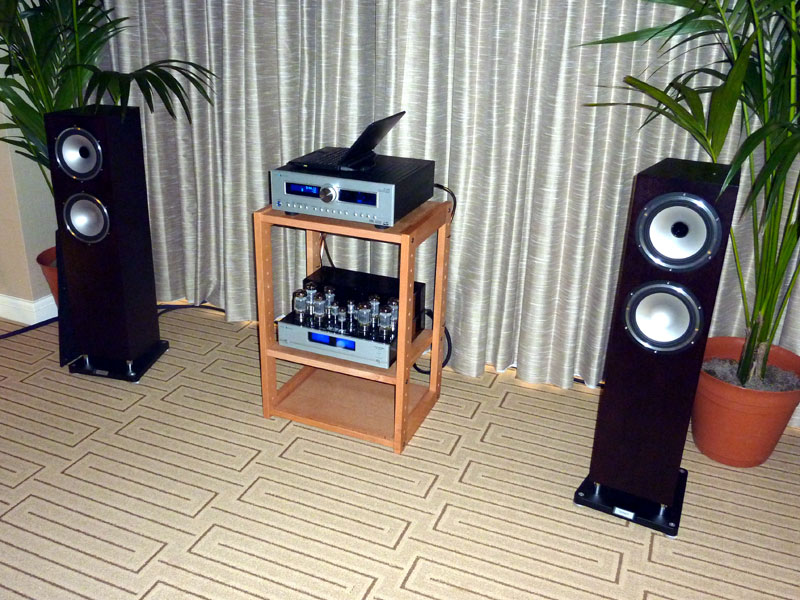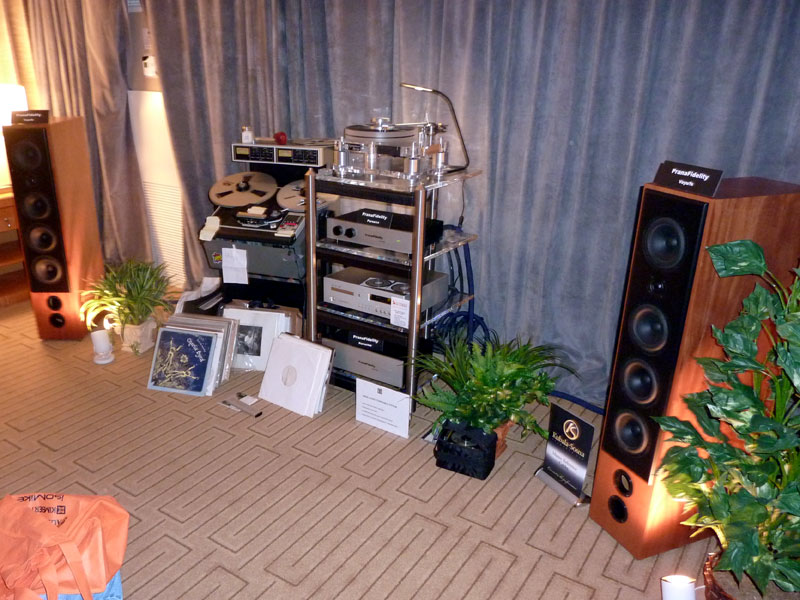THE Show Newport Beach 2015 • Mr. Record in Newport Beach
I know you've seen the words before: "This show was even better than last year's show." But, my fellow audio lovers, the 2015 Newport Beach show (which is held in Irvine) was indeed better than last year's show, and for a couple very good reasons. First, everything was housed under one roof. Bringing everybody together into one place made this a more unified show. When we're together, under one roof, we're more likely to run into old friends and find our favorite high-end brands. Also, the the used-record dealers, like my friend, Bob Donnelly, weren't relegated to a faraway location, under a staircase, behind a swimming pool, and inside the smaller and less opulent hotel. Instead of being degraded for their preference for selling older, odder, and for me the better repertoire, the secondhand-LP dealers shared the same room with Mobile Fidelity, Impex, and Analog Productions. Second, the staff at Hotel Irvine were wonderful. The employees of this hotel appear to really love their jobs. What a concept! Having met the director of operations, Norman Dillard, I now know that liking one's work is possible. And, let tell you about chef Jason Montelibano, the mastermind of The Eats restaurant. Chef Jason, as he is known to his co-workers, is a culinary wizard and a cool guy too. If the Hotel Irvine wasn't so far from home I'd return there just to enjoy Jason's great food. So you want my story, right? My 2015 show journey started on Saturday morning at 10AM. Just like last year and the year before, my partner in crime was my good friend and fellow vinyl junkie Frank Pernice. Frank and I spent two days at the show. My first responsibility at a hi-fi show is to check with the boss, as in Abey Fonn, the owner of Impex Records. Abey held my badge and paid for my hotel room, so she got the honor of experiencing Mr. Record before anybody else did. My second job was to deliver some vintage LPs I've accumulated for my friends Dan Meinwald and Danny Kaey. If you don't know these distinguished gentlemen, you should know them. Dan imports the famous EAR tube electronics from the UK and the amazing Marten speakers from Sweden. Danny is an import himself -- from Serbia -- and he's one of the positive voices at Positive Feedback and his own Sonic Flare site.
As I own the now-vintage EAR 864 preamp and I try to keep tend keep up with things EAR-wise, I made Dan Meinwald's room my first destination. Dan's room was no disappointment and, dare I say, it was indeed better than last year. Dan's system was connected to the wall via a Waveform Fidelity power cord ($1495), which was then connected to the World Power Power Wing ($2850). Plugged into the Power Wing was the EAR 324 solid-state phono stage ($6095), the EAR tube V 12 integrated amp ($9795), and the Helius Alexia turntable ($5000). Mounted on the table was the Helius Omega Silver Ruby 10" tonearm ($5225), and situated at the end of the 'arm was a Kiseki PurpleHeart NS phono cartridge ($3299). This combination was driving a pair of Marten Duke 2s ($8500/pair), which were sitting atop of a pair of the Marten stands ($1200/pair). I loved the original Dukes in an all-tube EAR system a few years ago in Las Vegas. At that time, Dan was supplementing them with the Marten Ellington subwoofers. This time Dan didn't have subwoofers, and, to be honest, while I didn't hear any pipe organ or The Pines of Rome, the speakers sounded fantastic all by themselves. The sound reminded me of sitting back and enjoying my records at home. In an average-sized hotel room, Dan was not projecting waves and waves of layered depth, which are something I never listen for anyway, nor was his background a blackened sea of mist. However, expansive waves of depth would be rather weird on a Kitty Wells LP. She sounded mighty fantastic in that classic, immediate-sounding, Decca Nashville way, and so did Dan's blue-label first pressing of Masterpieces By Ellington. The thing that matters most to me in an audio system is a sense of palpable reality. I get that when I use my EAR preamp, and that's the kind of sound I heard in Dan's room. Great stuff!
My next priority was to schlep the second heavy box of LPs to Danny Kaey's room. You may wonder why Danny, a reviewer, hosted a room of his own. Danny's purpose, at least as far as I was told, was not to promote equipment, although he was proud to show off a system that was close to the one that he currently uses at home. When I pressed Danny for the list of the equipment that was featured in his room, he insisted that the equipment was not his main reason for being there. However, I found it rather difficult to ignore Einstein's The Tube preamp ($30,000), The Turntable's Choice phono stage ($7800), and the Silver Bullet OTL power amps ($65,000/pair). This combo was driving a hard-to-ignore pair of bright-red Wilson Audio Sasha W/P 2s ($35,000/pair). The turntable was a Brinkmann Spyder ($14,000) with Brinkmann 10.5 tonearm ($5500) and Transfiguration Proteus cartridge ($6000). The reel-to-reel was a Sonorus ATR 10 ($14,000), which is a totally rebuilt Revox PR99. I have it on Bob Donnelly's word that the bass is even better at Danny's home, using these amps on a pair Wilson Alexias. I need to get over there -- my invitation is always open. I wonder how Einstein controls woofers without the use of output transformers, but for this kind of bread I guess anything is possible. Danny might have been there mainly to promote his websites, but if he had any intention of people ignoring the system he failed in his attempt.
After relieving myself of the heavy LPs, Frank and I were able to enjoy the show at our leisure. I'm not very good at figuring out a best way to get around the show. Frank is better at using the show directory. Left on my own, I tend to wander and let the sounds carry me from room to room. Neither of us owns a music server, and neither of us wants to sit in rooms with bad sound and bad music. Some rooms were a hoot. For example, I've never heard the Edgarhorns sound anything but weird, and I didn't think the USA Tube Labs Tineo J horns ($59,000/pair) sounded much different. On the other hand, there are some great-sounding speakers that use horns, like those from Westlake Audio and Tannoy. Okay, maybe a dual-concentric Tannoy is not exactly a horn, but it is close. I heard some new Tannoys that were driven by Cary electronics (TL-300d preamp, $6000-$8000 when shipping and CAD-120S Mk II amp, $5795) that sounded great. The Cary-driven Tannoy Revolution XT-8F speakers ($2600/pair) sounded effortless -- in fact, more so than electrostatic speakers. But a horn with excessive horn colorations doesn't seem like high fidelity to me. Another hoot was the big-room/small-system approach, most notably the one that Mike Slaminski of Precision Audio has been using for years. Mike's use of ballrooms always makes me think of a private plane residing in a 747's hanger. No matter what he's demoing, the sound is the same. I suspect that the Thrax system Mike displayed (DTA Maximinus DAC, $33,000; Dionysos preamp, $21,000; Tera monoblocks, $30,000/pair; Lyra speakers, $20,000/pair) is wonderful, but all I heard was the boundaries of the unnecessarily large room adding their own personality. Mike's sound at this show, and last year's show, was the same as the sound that I heard years ago in his store. Mike likes this kind of sound, and apparently so does his clientele, who probably live in those large reverberant homes by Lake Sherwood. He certainly has a sonic signature that's all his own. If you like huge waves of depth and enormous soundstages on everything you play, go see Mike. On Sunday I poked my head inside Ray Kimber's room. His Isomike recordings intrigue me, because Ray records high school bands and choirs, and I happen to love band and choir music. However, when I dropped by, nobody was in the room. Perhaps Ray is still sticking to scheduled demos. Standing in line to get into a room is a personal peeve of mine, but there was no sign or a person to tell me what was happening. I still own the set Kimber 4PR speaker cables that Ray gave me and my co-workers back in 1982. Good stuff, Ray.
One of the greatest pleasures came from a room on the third floor hosted by Alfred Kainz. Alfred, a German import himself, imports of some amazing audio equipment from Germany and France. Alfred also now resides in one of my former hometowns, Apple Valley, CA. Alfred was a gracious host, and his sound was in the knockout category. It takes a lot to impress me with gear that I've never heard of, but Alfred had no trouble doing just that. Alfred's music was stored on a laptop, and if you want know the size or the type of files he was using, you'd better ask him. What I can tell you is the laptop was feeding a Total DAC D1 tube DAC ($10,000) from France, and that was feeding an Aurorasound Preda solid-state line stage ($12,000), also from France. The French gear was then fed into a pair of German-made Wall Audio M50 50-watt SET amplifiers ($11,750/pair). The speakers, from Germany, were the Langerton Configuration 217 ($15,000/pair), a two-way design that didn't exactly look impressive, but when does a two-way dynamic speaker look impressive? The sound was, in a nutshell, correct and very satisfying. When I entered the room, Alfred was playing unfamiliar music, which tends to be norm when I'm dealing with laptop-based music systems. Under these conditions, I would normally leave pretty rapidly, but this was different. There was a rightness to the sound that invited me in to sit down and pay attention. Soon I was ready to hear more, and more meant asking to hear something familiar. My request for country music didn't pan out, but when I asked for some jazz, Alfred offered up Cannonball Adderley's famous recording of "Autumn Leaves." That was a genuine treat, and the only words to describe the sound are correct and accurate -- which are among my favorite words, but when these adjectives are delivered with a flowing sense of pleasure we have true fidelity. This gear was expensive, but it also delivered. An even greater treat, and a nice surprise (thank you, Alfred), was the now-famous bootleg version of Peggy Lee's "Fever." If you haven't heard this classic recording freed from the bondage of reverb and compression, go find your nearest dark alley and ask for it. Before I wrap up this wonderful room's description, I must elaborate a bit about one of the most unique products I saw and sort of heard at the entire show. What I am referring to is the PMR Passive Multi-Vocal Resonator ($2590 each). A pair of them were placed in the upper corners of the room, behind the speakers. Now, I'm no stranger to unusual room treatments, as I own a set of Shakti Hallographs, but a pair of machined bronze bowls in an audio setup looks pretty strange. According to Alfred, they can be used singularly or in pairs, and I would assume that three or more could work in larger rooms. Perhaps I should have asked to have them removed, but I was having far too much fun listening to Cannonball and Peggy to have any interest in tweaking the system. Maybe down the road I could ask for a pair to try (hint, hint). While strolling down a hallway, Frank and I stumbled onto the Herron Audio room. How could anybody not like Keith Herron, and how could anybody not love his sound? Keith was running his highly regarded VTSP-3A tube line stage ($6550) and his solid-state model 1A mono power amps ($6850/pair). His gear was driving a set of Audio Physic Avanti 3 speakers ($11,000/pair). Although he had on hand his phono stage and a Rega turntable, when I was there he was getting great sound from CDs via a Meridian G-08 CD player ($4000). I really liked Keith's sound. It reminded me of my sound, which could in part be because of the tubed preamp driving solid-state amps. I tend to like hybrid systems, because they combine benefits of tube warmth and solid-state clarity. Keith's sound could easily be my sound, and the same for his gear!
I'd like to wrap things up with my adventure in the PranaFidelity room. In the past I had only seen Steven Norber from a distance, but this was my first time meeting him. Steven is one of those audio celebrities who's hard to ignore. He projects a unique form of energy, and he must have as lot of it since he came from Colorado by motorcycle. The next time I see him I need to find out what kind of vitamins he's on. Many audiophiles know Steven from the gear he designed for Edge Electronics. I believe that his Edge designs are still on the market, or at least it looks that way based on a still-active website. I only had one Edge experience, and that was a a few years back at the Rocky Mountain Audio Fest, and the product was one of the amplifiers. In this one instance the large Edge amp was outperformed by a paralleled single-ended 300B amp. I should, however, mention that this was on only one recording, of Stan Getz, and the speaker was the original Marten Coltrane, a speaker that tends to sound better with tubes. Other than that, I have never heard any Edge gear. This time with Steven's PranaFidelity system I paid very close attention, and I loved what I heard. Although Steven had on hand a Luxman D-08 CD/SACD player ($17,990), I listened to LPs in his room. One thing that means more to me than format is when people play music that I know. Steve happened to have a copy of a genuine audiophile classic, the Charlie Byrd LP on Crystal Clear. I love that album and still consider it one of the Byrd's best records. Back in the days of my first high-end show, in 1978, the direct-to-disc Byrd LP was famous for featuring one of the most dangerous drum solos on record, a real amp-clipper. It still sounds amazing, and the percussion still sounds mighty dangerous. Steven's system played the old classic with ease and authenticity. Although he's is not in the turntable business (at least not yet), he's now in the speaker business, as well as electronics. The system was fed with a Basis 2200 Signature turntable ($7350), Basis Superarm 9 tonearm ($16,000), and a MY Sonic Labs Ultra Eminent ($6395). On the printed list of equipment a Miyajima Shilabe cartridge was shown, but according to Steven the MY Sonic Labs MC sounded better. Having heard the Miyajima sound so good in Jeff Catalano's system, I wouldn't have minded hearing the difference for myself, but I'm sure the issue had more to do with system compatibility than quality of design. Some perfectly great cartridges don't sound right with my preamp. Most important, the sound was incredible. I would have no trouble owning a PranaFidelity Purma preamp ($9950 with phono), Puma 400Wpc amplifier ($8950), and Vayu/FS speakers ($6950/pair). I know the old Charlie Byrd LP very well, and the guitar sounded especially natural, and so did that famously dangerous drum solo. Would I give up my tubes for this gear? Hard to say. Give
me a chance to compare and Ill let you know. |





